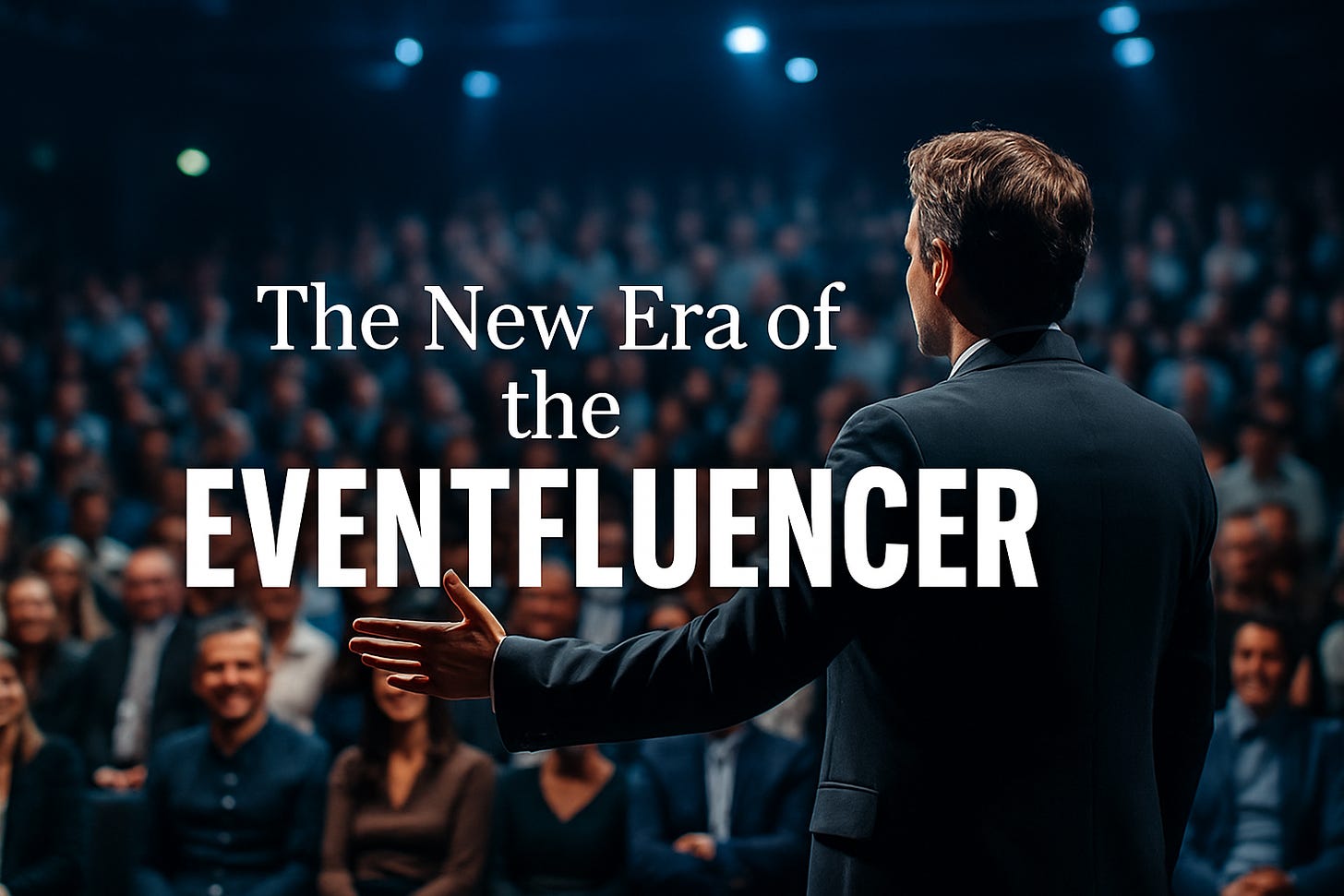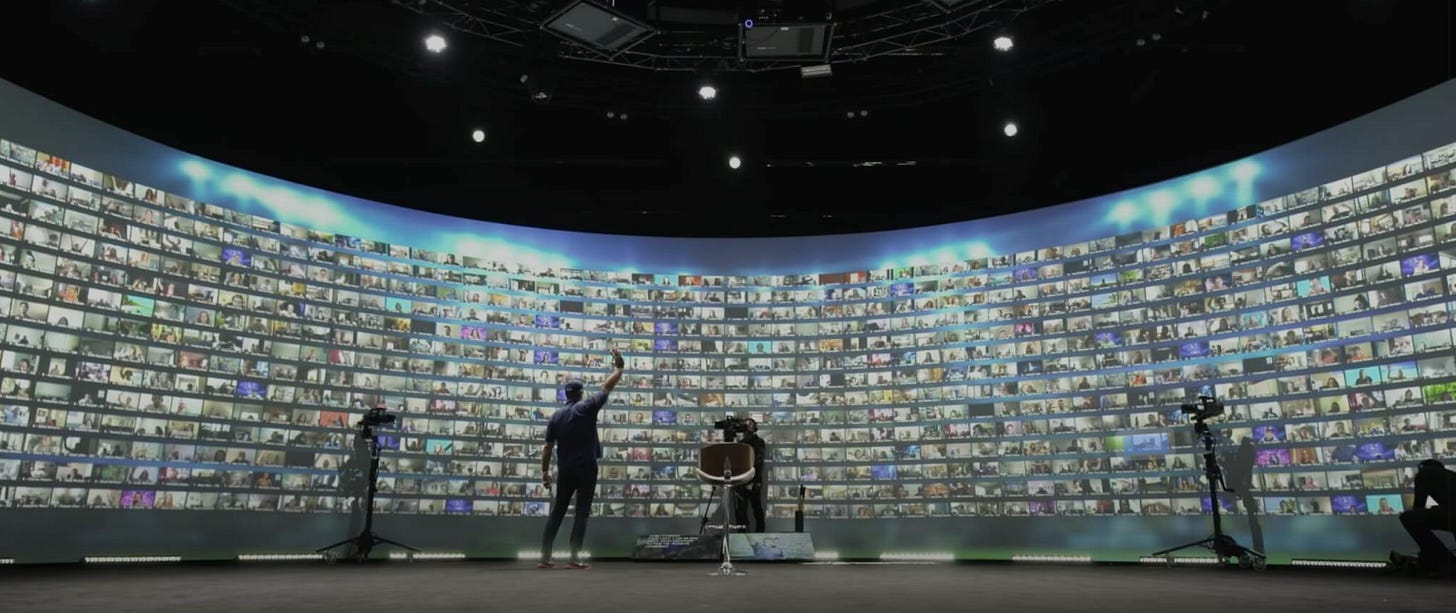How Eventfluencers Are Rewriting the Rules of Live Events
A new class of creators is blending charisma, community, and cutting-edge hybrid tech to fill rooms, break the fourth wall, and challenge the events industry to keep up.
For more than a century, in-person events have been the ultimate stage for influence. Ballrooms, boardrooms, convention centers, stadiums—the architecture of gathering has powered commerce, culture, and politics alike. The events industry built its empire on these spaces, perfecting the choreography: run-of-show precision, lighting and sound as emotional instruments, sponsorship calculus baked into seating charts.
Now, a new force is moving in. I call them Eventfluencers—digital-native personalities who can fill a room without a traditional marketing campaign, sell out a theater without a sales team, and turn followers into ticket-holders with a single post. They arrive with something the events industry has always coveted but never truly owned: an audience that already belongs to them.
This isn’t entirely new. A decade ago, Tyler Oakley and Dan & Phil could sell out venues on novelty alone. But their shows, however charming, largely bypassed the industry’s infrastructure. They were treated as curiosities, not cornerstones.
Today’s Eventfluencers are different. They are strategic. They understand brand integration, tiered ticketing, merch drops timed to applause breaks. They think in both room-scale and world-scale. They know that a live audience—its applause, its collective gasp, its selfies on the step-and-repeat—is the ultimate algorithm.
And they are discovering something the events world has always known: the magic is in the room. Neuroscience proves it—face-to-face interaction triggers oxytocin, deepening trust; novelty sparks dopamine, priming people for engagement; synchronized rhythms—laughter, applause, stillness—create a felt sense of belonging no platform can replicate. For a creator who has spent years talking at a camera, the first time they talk to their audience in the same airspace is transformative.
They are emerging from every corner of culture. In tech and media, Kara Swisher turns Pivot into sold-out salons; Scott Galloway packs MBA halls and global stages. The Pod Save America team learned early how to take political conversation on the road. Comedy’s new guard—Theo Von, Marc Maron, the Emergency Intercom duo—tour like rock acts.
Alex Cooper’s Call Her Daddy, recognized by The Hollywood Reporter as one of the most powerful properties in podcasting, sells out arenas while expanding into media ventures. Beyond the U.S., Steven Bartlett, host of The Diary of a CEO and a Dragons’ Den investor, is demonstrating how business storytelling can pack theaters from London to Sydney. Shawn Ryan, a former Navy SEAL whose Shawn Ryan Show mixes long-form interviews with investigative storytelling, has built a fiercely loyal audience—one that could easily fill auditoriums or hybrid broadcast studios. These figures join others on THR’s list who’ve proven that audio dominance can be a launchpad for face-to-face engagement.
LadyGang’s Keltie Knight, Becca Tobin, and Jac Vanek have built a touring pop-culture franchise. Beauty’s power players—Mikayla Nogueira, NikkieTutorials, Safiya Nygaard—could pivot to hybrid masterclasses overnight. Tradespeople like Barbie the Welder, Laela Holden, and Women Who Weld show that craft carries as much audience pull as celebrity. Food and culture figures like Sean Evans of Hot Ones and Maria Liberati are building stage-ready formats. Wellness leaders like Jay Shetty and Mel Robbins already draw thousands in person and tens of thousands online.
The niches are infinite. The audiences are pre-sold.
And it’s not just independent creators making this move. Legacy media is starting to operate with the Eventfluencer playbook. MSNBC, for example, has been building out its live events portfolio, with Luke Russert serving as Live Host and Creative Director. One of the network’s upcoming projects is designed not for the sprawling, diffuse TV audience, but for a smaller, high-intensity room of super-engaged attendees.
It’s a strategic shift. When the raw audience numbers get smaller, the intensity has to get bigger. The goal is to make every attendee feel they are part of something irreplaceable — that being in that room is worth more than a hundred casual views from home. That’s Eventfluencer logic applied to institutional media: deepen loyalty, drive emotional investment, and let the in-person experience become the content engine for everything else.
And now hybrid technology has widened the stage. Done right, hybrid isn’t “streaming the show”—it’s a second front row. The engine making that possible is Immersive Design Studios’ CANVAS software, which powers some of the most advanced hybrid environments in the world, including Worre Studios in Las Vegas, Quorum by Convene in New York, and others. CANVAS turns remote participation into a fully interactive 3D experience: multiple camera angles, close-ups you can’t get from Row Z, breakout rooms where networking feels human. Worre integrates those virtual guests into the live environment—their faces on massive LED walls, their voices in the conversation, their votes shifting the room. Quorum blends the intimacy of a private broadcast with global reach.
The artistry is in breaking the fourth wall. Oprah Winfrey did it instinctively at a Weight Watchers global town hall at Quorum, looking straight into the camera and repeating, “I can see you”. In that moment, she collapsed the distance between Manhattan and the millions watching worldwide. It wasn’t two audiences—it was one, fully seen.
No one has scaled that intimacy like Tony Robbins. His events—Unleash the Power Within, Date with Destiny—fill arenas while attracting hundreds of thousands online, sometimes over 800,000 for a single series. Through the latest innovations in hybrid, Robbins’ virtual participants don’t just watch; they participate. They join small-group breakouts, vote in real time, and enjoy vantage points even VIP seats can’t match. He’s turned the hybrid stage into a global marketplace for belonging, and his conversion from first-time attendee to long-term client is the envy of any brand.
How Event Organizers Respond
For the traditional events world, the temptation is to defend the old turf. But audiences follow energy, not gatekeepers. The smart move is to partner. That means offering what Eventfluencers can’t easily build themselves: the operational backbone of large-scale gathering—venue sourcing, production design, hybrid integration, sponsorship sales—without flattening their brand voice.
It means rethinking format. A political commentator with a rabid podcast following doesn’t need a ballroom set up for a trade panel; they need an environment that feels like a DM with the energy of a concert. A craftsperson like Barbie the Welder might only fill 500 seats in-person, but with a hybrid package she can reach tens of thousands more, monetizing both ticket tiers equally.
And hybrid should be positioned not as a bolt-on, but as a creative equal—two stages, one show. When Worre Studios brings the remote audience into the room on massive walls, or Quorum by Convene frames its broadcast with the same care as the in-room sightlines, it stops being “in-person with a livestream” and becomes a shared experience.
The Eventfluencer Strategy
For the Eventfluencer, the game is to protect the trust they’ve built while expanding the ways their audience can gather around them. That means treating live events not as one-off “specials” but as a core part of their brand ecosystem — as essential as their podcast, YouTube channel, or social media presence.
The first priority is intimacy. Whether the room holds 50 people or 5,000, the Eventfluencer’s superpower is making each attendee feel personally seen. That’s the currency they can’t afford to dilute. It’s why a smaller, high-intensity room can sometimes be more valuable than a stadium — because in this model, depth of connection beats breadth of reach.
The second priority is scalability — and that’s where partnership comes in. The Eventfluencer doesn’t need to become a logistics expert, but they do need to choose partners who can scale their experience without sanding off the edges of their personality. The right collaboration with a corporate events team, a trade show organizer, or a hybrid production facility lets them add cities, grow audiences, and layer in virtual attendance while staying true to their voice.
The third is monetization that feels organic. Eventfluencers should design revenue streams — sponsorship, merchandise, digital extras, hybrid ticketing — so they grow naturally out of the experience, not bolted on in a way that feels transactional. A sponsor on stage should feel like a collaborator in the story, not a billboard interrupting it.
And the final priority is rhythm. Like a tour schedule or a TV season, the most successful Eventfluencers will build a predictable cadence of live moments their audience can anticipate. They’ll turn “I went once” into “I go every year.” In doing so, they move from being content creators who sometimes go live to being experience brands whose gatherings are as much a fixture as their online content.
The Business Model
The reason this partnership works is simple: each side holds what the other lacks. Eventfluencers bring an audience that already trusts them, a cultural momentum that can’t be bought. Organizers bring the muscle — scale, monetization, and the production craft that turns charisma into an experience worth paying for.
When the two work together, the revenue opportunities multiply. A co-branded tour can split the gate and the sponsorship dollars, turning a one-off appearance into a recurring property. Hybrid ticketing can sell the same show twice — the seat in the room at a premium, the interactive virtual pass at scale — each with its own pricing logic and upsell path. Sponsorship becomes a double play, with activations living both in the physical environment and inside the virtual feed, reaching audiences who will never set foot in the venue but will still feel part of the event.
A hit format can be licensed, moving from city to city, culture to culture, with the Eventfluencer’s brand intact and the organizer’s infrastructure invisibly carrying the load. Merchandise and digital extras can drop in real time, available to everyone watching — a limited-edition poster for the audience on-site, a downloadable masterclass for those online, both sold while the applause is still echoing.
This is not a single revenue stream; it’s a latticework. Done right, the financial model mirrors the creative one — integrated, cross-platform, built for longevity. The upside isn’t just shared; it’s doubled.
In the end, it’s simple: the audience already knows who they want to see — and they’ll follow them anywhere. The only question is whether the events industry will be smart enough to build the stage, light it, and open the doors… or stand in the lobby watching someone else do it.




